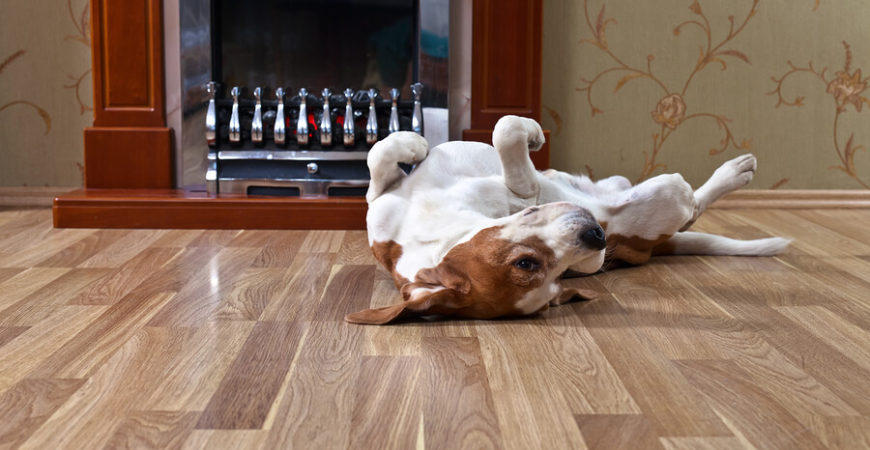The Pet Owner’s Guide to Flooring – Part 2: Protecting Your Flooring Investments
- Published By: District Floor Depot

Flooring is expensive, and homeowners who make time, effort, and monetary investments in having new floors installed likely want to do everything they can to make those investments last as long as possible.
Installing new floors in a pet-friendly home might seem like a terrible idea, particularly when one considers the inevitable wear and tear from nails and claws, messes that will undoubtedly occur, fur and dander sure to be shed, and various unknowns that are bound to crop up.
Proper care can ensure any flooring investment lasts. Knowing how to care for your floors in a way that will mean even the rowdiest of dogs and most rambunctious of cats can’t do a number on them is key to making that happen. This quick guide is your first step toward getting the most out of your pet-friendly home’s important — and costly — flooring investments.
The Care and Keeping of Floors in a Pet-friendly Home
Carpet
This post talked about how well carpets hold up against pet claws and nails, but that doesn’t mean they’re the perfect fit in pet-friendly homes. Protect your carpet investments by vacuuming regularly, and have them and other plush surfaces deep cleaned a few times per year to ensure they stay the texture and color you originally selected. Keep pets’ nails trimmed to avoid snagging, and give cats their own designated scratching posts to minimize kneading and sharpening on your carpeted floors.
Clean up messes as soon as possible, too — including those from spilled water, food, slobber, or bodily functions — thereby mitigating issues with staining, odors, and other unpleasantness.
Vinyl
Like carpet, Vinyl is relatively resistant to the impact of pets’ nails, meaning all you’ll really have to do is sweep and mop to keep it looking nice. Unlike carpet, which often hides shedded fur and dander, your vinyl floors will very much show those loose tufts and dustlike piles.
Sweep and vacuum regularly to keep that extra dust and fur to a minimum, then use a vinyl flooring cleaner to achieve a deep clean. There are products for both low- and high-gloss vinyl that protect and restore the original vinyl finish. Use these at least once per year to keep your vinyl floors’ shine going strong.
Stone and Tile
Another option that stands strong against pet nails and claws, stone or tile is very easy to maintain. Like vinyl, though, they will likely show signs that a pet lives in your home: Tufts of shedded fur or dust will likely gather in corners or in the seams between stones.
Luckily, protecting your stone floors is relatively easy to do. Simply sweep away dirt and dust to alleviate that buildup, then mop with a stone or tile-specific cleaner and rinse with a wet mop whenever you need a refresh. Let your floors air dry or towel them off to save time, and speak with your flooring expert about when to have your tiles and stones resealed.
Hardwood
Last week, we mentioned that hardwood is the least pet-friendly product on our list, but that doesn’t mean you can’t have hardwood floors in your home. It just means the option requires the most intricate care to protect it against everyday life.
Start by applying multiple layers or an extra-thick layer of finish to create a strong anti-scratch barrier between pet nails and the expensive wood. This clear coat absorbs scrapes and scuffs from nails and claws, protecting the woods from wear and tear. This will need to be sanded down and redone periodically, and your flooring expert will help you determine when that needs to be done.
Also, some hardwood species are more durable than others. If you have pets and are considering installing hardwood flooring, ask your local hardwood flooring retailer about what options are available.
Cork
As with hardwoods, a sealing coat should be applied to protect cork floors against pet nails and other related damage. There are several options available, each with pros and cons. Polyurethane strengthens floors against water damage and staining but makes them easier to scratch. This might work out fine for homes with declawed cats, as scraping and scratching will be minimal if it exists at all.
A wax finish creates a protective barrier against stains, spills, and scratches and makes the floors shiny — which is great for homes with cats, dogs, ferrets, and others with claws or nails — but must be reapplied every six to 12 months to keep it fresh. This would be something to cost out with your flooring expert to determine the best solution for your family. In fact, a flooring expert will be a good resource for those looking to maintain cork flooring — or floors made from any other material — in a pet-friendly home. Look to him or her to answer your questions and provide information on the best protection and maintenance options.
The Right Professional Makes a Difference
When you have questions, issues or concerns regarding pet-friendly solutions, having the right professional to help you navigate your options is essential. Trust your home’s flooring solutions to an industry-proven, time-tested provider like District Floor Depot, a team that’s always ready to help you get the most from your flooring investments.


